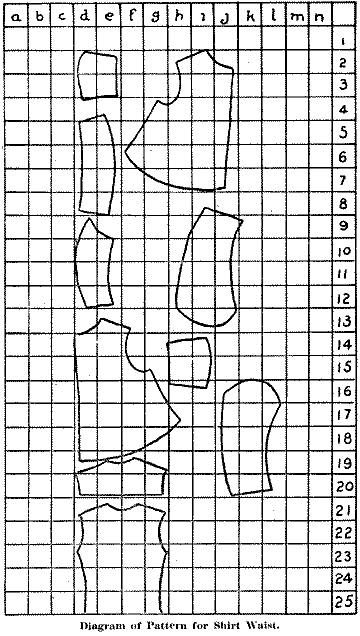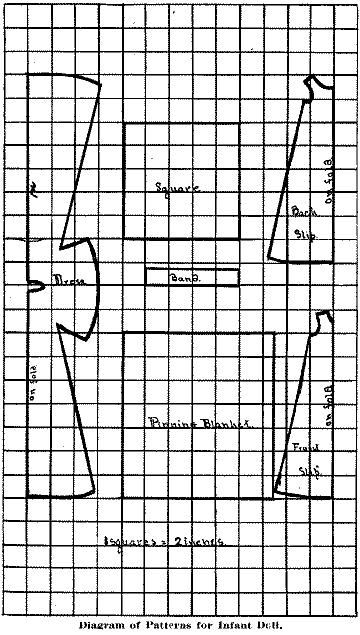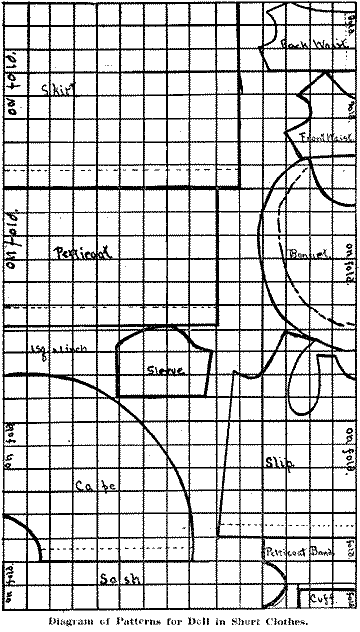NEGenWeb
Project
Resource Center
Schools
|
|
259 |
Directions for Making the Petticoat:
Before making the petticoat, you will have to take your measure and block out a pattern.
The petticoat requires 6 inches more than twice the length of your skirt, and a piece of muslin cut lengthwise for a band, 2 1/2 inches wide and 2 1/2 inches longer than your waist measure. White muslin, outing flannel or seersucker may be used for making the skirt.
Have someone take two measurements; the first one the length the skirt is to be when finished, the second your hip measure taken four inches below the waist line.
|
Hip |
Top of Front |
Bottom of Front |
Top of Side |
Bottom of Side |
|
24 |
3 (bd) |
4. 1/2 (ce) |
6 1/2 (RM) |
9 (ln) |
|
26-30 |
3 1/2 |
4 3/4 |
7 |
9 1/2 |
|
32-34 |
3 1/2 |
5 |
7 1/2 |
10 |
|
36-40 |
4 |
5 |
8 |
10 1/2 |
The pattern in the cut is made for those whose hip measurement is 26 to 30 inches and who wish the petticoat 26 inches long when finished. Three-eighths of an inch is allowed for seams.
To make the pattern, rule a piece of plain paper in two inch squares, then copy the pattern from the scale to the ruled sheet. In the table of measurements the top of front is measured along the line "bd," which is four inches below the waist line. The bottom of the front is measured along the line "ce" and the length of your skirt on "ac" and "gf." The top of the side gore is measured on "km" and the bottom of the side on "In." If your hip measure is not between 26 and 30 inches, find the correct measure in the table and make your pattern accordingly. If your measure is an odd number of inches, take the next higher number in making your pattern.
After cutting the pattern carefully, fold your goods through the center with selvedges together. First cut a straight piece 29 inches long for the back, if the skirt is to be 26 inches long when finished. Next, pin the pattern marked "front" with the straight edge on the fold of the goods. Cut the cloth three inches longer than the pattern to allow for a hem.
Place the pattern for the "side" on the remaining goods, allowing 3 Inches on the bottom for a hem. Pin carefully and cut out.
If you wish the petticoat longer than 26 inches when finished, allow the extra length when making your pattern.
To make the skirt, baste the front to the straight edges of the side gore. Baste the straight back piece on to the side pieces, leaving the left side open ten inches to allow the skirt to slip over the shoulders. Gather the top of the skirt twice. Try the petticoat on, arrange most of the gathers in the back with enough over the hips to let the skirt fit smoothly. Stitch the seams and overcast them.
Pin to the band. Baste the band on
the wrong side first, then
9
|
260 |
|

|
|
261 |
turn on the right side and baste. Stitch. Finish the band with a button and buttonhole.
Turn up a three-inch hem evenly around the bottom. If of flannel, hem by hand, otherwise on the machine or by hand. Overcast all seams.
The petticoat may be trimmed or not as you desire.
In cutting the shirt-waist let each square represent three inches. To make the pattern, rule a piece of plain paper in three-inch squares, then copy the pattern, from the scale to the ruled sheet. After making a careful drawing of the eleven pieces, cut them out.
The waist requires 2 1/2 yards of 27-inch material. Any lawn, percale, gingham, or India linon (sic) may be used, and should be shrunk before making to prevent its being too small after washing.
Three eighths of an inch is allowed for seams. Pin the pattern on the material, arranging the parts just as shown in the cut, that the waist may have all the parts for right and left sides.
When the waist is cut out, turn a 1/4-inch scam across the bottom of the yoke and place on right side of back, baste in place and stitch twice across the bottom of the yoke. The first row of stitching should be 1/8-inch from the edge of the yoke, and the next row just above this one.
Next place right sides of the front and back together and baste across shoulders and under arms, 1/2-inch from the edge of the material.
Baste upper and under parts of sleeves together, allowing the regular 3/8-inch seam.
Gather twice across the top of the sleeve and scratch the gathers to make them smooth. Gather the bottom of the sleeve in the same way. Cut out two pieces the same size as cuff. Baste the two pieces together right side out, through the center, then place right side of the cuff on this lining and baste close to the edge. Sew around bottom and two ends on the machine. Press seam open with finger nail, turn and crease a seam 3/8-inch deep across lining and outside. Turn the cuff. Pull gathering thread in bottom of the sleeve until it just fits the cuff, insert 3/8-inch in open end of the cuff and baste. Baste under arm seam of the sleeve.
Repeat with the other sleeve.
Baste sleeves in the waist, placing gathers on the top of the arm; and under arm seam of the sleeve one inch in front of the under arm seam of the waist. Try on, make necessary alterations. Stitch on the machine. Baste a one-inch hem on the left side of the front and a 1 1/4-inch hem on the right side. Hem by hand, allowing the stitches to show as little as possible.
Cut a straight strip of material 1 1/2 inches wide, 3/4 inch longer than the neckband of a waist which just fits you. Hold the right side of the band on the wrong side of the neck of the waist, baste and stitch.
Crease a 3/8-inch seam on the three remaining sides of the band, fold
|
262 |
|
on right side to just cover the row of stitching. Baste and stitch. For the collar use a piece of embroidery or insertion of a suitable width, hem the ends by hand and fasten with three very small buttons. Catch the center of the front firmly to the band of the waist. The goods may be cut and hemmed for a collar if desired.
Fasten the front of the waist with buttons and buttonholes placed three inches apart. Hem the bottom of the waist. Turn the cuffs back and fasten with one button and buttonhole. Overcast all seams.
1. COOKING:Corn Bread:
3/4 cup cornmeal
1/2 tsp salt
1 1/4 cups flour
1 cup milk
1/4 cup sugar
1 egg
4 tsp baking powder
1 tbsp melted butter
Mix and sift dry ingredients; add milk, egg well beaten, and butter; bake in shallow buttered pan in hot oven 20 minutes.
Ginger Cake:
1/2 cup butter creamed
1 tsp cinnamon
1/2 cup sugar
1 tsp ginger
1 cup molasses
1/2 tsp cloves
1 tsp soda in
1/4 tsp allspice
1 cup boiling water
1/2 tsp salt
2 cups flour
2 eggs well beaten
Mix well and bake in two layers 30 minutes in moderate oven.
Icing:
Reserve one yolk, beat it until lemon colored and add gradually 1/2 to 3/4 cup powdered sugar and a few drops lemon extract.
Spread between layers.
Grape Juice:
Wash the grapes and pick from the stems. Put the fruit in the preserving kettle and crush slightly. Heat slowly and boil gently for half an hour. Crush the fruit with a wooden spoon.
Put a sieve or colander over a large bowl and spread a square of cheese cloth over the sieve. Turn the fruit and juice into the cheese cloth; drain well, then draw the edges of the cheese cloth together and twist hard to press out all the juice possible.
Put the strained juice in a clean preserving kettle and on the fire. When it boils up draw back and skim. Let it boil up again and skim; then add the sugar and stir until dissolved. Boil five minutes, skimming carefully. Fill hot sterilized jars or bottles. Put the jars or bottles in a moderate oven for ten minutes, in pans of boiling water Have some boiling juice and pour a little of it into the jars as they are
|
|
263 |

|
264 |
|
taken from the oven; then seal. Place on boards and set aside out of a cold draft.
A good proportion of sugar and juice is 1/2 cup of sugar to a quart of juice.
2. SEWING:Infant Doll:
Each girl in the club, who is under 16 years of age, will dress a ten-inch doll in infant clothes. The set includes a one-piece dress, slip, pinning blanket, and square shawl.
The patterns are on the opposite page. On the scale each square equals two inches. To make the pattern, rule a piece of plain paper in two-inch squares, then copy the pattern from the scale to the ruled sheet. After making a drawing of the six pieces, carefully cut them out.
For the pinning-blanket white flannel is the best material. Hem the bottom with a one-half inch hem and the two sides with a 1/4-inch hem. Gather the top twice and set in the hand just as the skirt in last month's work was put into the band.
For the slip a piece of soft muslin may be used. After cutting the slip cut a slit 5 inches in length down the middle of the back piece so the garment can be slipped over the doll's head. Hold right sides together, take a 1/4-inch seam on the shoulder and under arm seams and overcast. Baste a 1/2-inch hem around the bottom, hem it down, using very fine stitches, or stitch it on the machine. Turn a very small hem around the opening in the back and sew it down. Try on the garment. Face the neck and arm-holes with the bias facing which is furnished you. Put the facing on neatly, basting and stitching it on the wrong side first, then fold it over on the right side and hem it down. Finish with two very small buttons and buttonholes.
To make the dress use India linon (sic), lawn, dotted swiss or some dainty and light material.
After cutting, fold the material across the shoulders and take a 1/4-inch seam on the side seam and under arm. Make a five inch opening in the back and finish same as slip. Run a 1/2-inch hem around the bottom, one-fourth of an inch above that a 1/8-inch tuck, and one-half an inch above that another 1/8-inch tuck. Between the two tucks insert a row of feather stitching, using No. 50 thread doubled. Run a very narrow hem around the bottom of the sleeve and gather to fit the doll's wrist. Finish the neck with some of the bias binding just as the slip was finished. Finish the neck and sleeves with very narrow lace over-banded on. Sew three very small buttons on the back of the dress and work the buttonholes.
For a shawl a piece of white flannel worked with white, pale blue, or pink is very pretty. Work the edges of the ten-inch shawl in the loop stitch with a French knot between each loop like the square you sent in last month.
This finishes the infant doll's set of clothes, and she is ready for the contest.
|
|
265 |

|
266 |
|
Twelve-Inch Doll in Short Clothes:
Each girl in the club, who is over 16 years of age, will dress a twelve-inch doll in short clothes. The set includes a slip, petticoat, dress and Red Riding Hood Cape.
The patterns are on the opposite page. On the scale each square equals one inch. To make the pattern rule a piece of plain paper in one-inch squares, then copy the pattern from the scale to the ruled sheet. After making a drawing of the eleven pieces, carefully cut them out.
For the slip and the petticoat a piece of soft muslin may be used. After cutting the slip, take a 1/4-inch hem on the shoulders, and up the back to within four inches of the neck. Turn a very small hem around this opening and hem it down. Baste a 1/2-inch hem around the bottom and catch the center of the hem in front to the center of the hem in the back. Finish the neck and arm-holes with the bias. Baste and stitch the bias on the wrong side, then fold it over on the right side and hem it down. Finish with two very small buttons and buttonholes.
After cutting the petticoat sew a 1/4-inch seam to within two inches of the waist line. Hem the opening. Baste a 3/4-inch hem in the bottom and stitch or overhand it. Gather the top twice and insert in the hand, just as the petticoat last month was sewed in the band. Finish with button and buttonhole. Trimming may be used on the underclothes if it is desired.
To make the dress, place right side of backs on right side of front. Take 1/8-inch seams on shoulder and under arm seams. Sew up skirt, following directions for making the petticoat, setting it on. wrong side of the waist instead of in the band. Cover raw seam with a piece of bias. Try the garment on the doll and hem backs. Finish neck with the bias and three buttons and buttonholes. Gather bottom of sleeves, insert in cuffs, sew up the sleeves, gather tops and sew in waist, bringing the under arm seam of the sleeve 1/4 inch in front of under arm seam of the waist. Finish neck and sleeves with very narrow lace. Cut the sash, hem by hand, making a very narrow scam. Finish all around sash by overhanding the narrowest lace all around. In putting the sash on, tie one short loop up and two long ends hanging to the bottom of the skirt.
For the cape a piece of red flannel is good. Make a 1/2-inch hem down the front of the cape and a very narrow hem around the bottom. Hem by hand. Gather the neck of the cape and the neck of the bonnet, fit to the neck of the doll, and sew together with seam on the right side. Gather the bonnet around the dotted line to fit doll's head. Finish with ribbon to match the cape you have made.
This completes the twelve-inch doll's set. Watch for the notice of the contest.
 |
 |
 |
 |
|
© 2003 for the NEGenWeb Project by Ted & Carole Miller |
|||